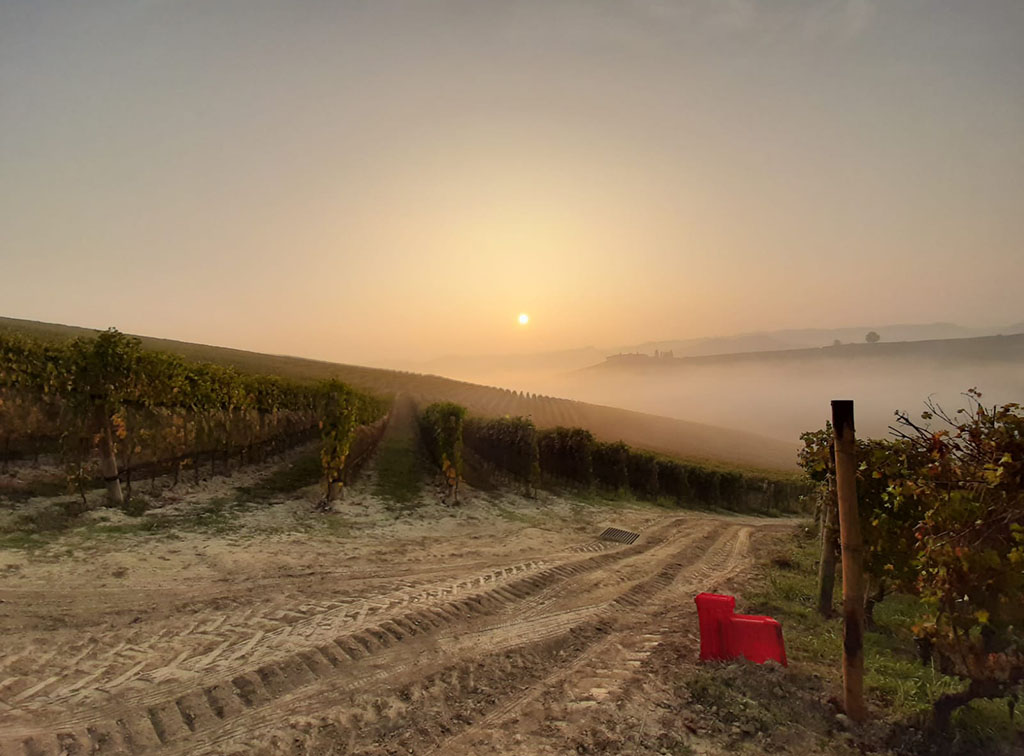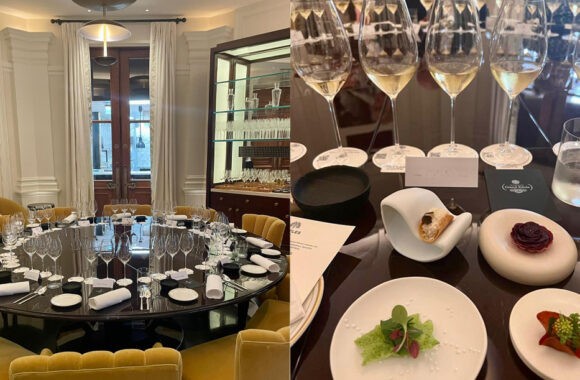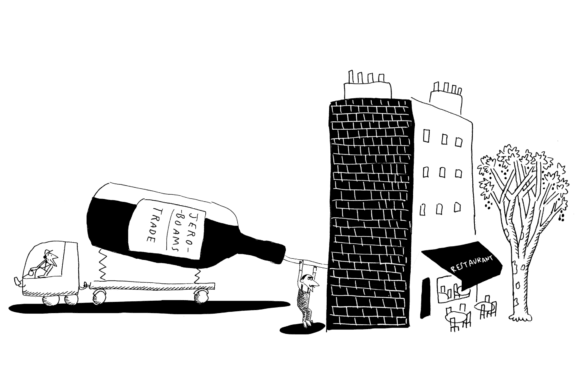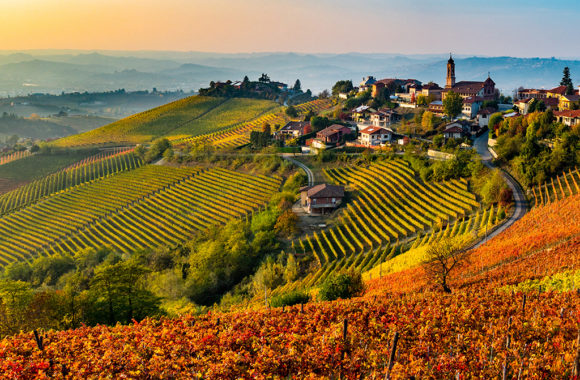
Tasting Piemonte: Day Three
· Luke Cianfarani Luke Cianfarani on
“If you haven’t discovered Piemonte yet, then go seek this magical region before it realises quite how good it is.”
Our final day would take in the important Barolo communes of La Morra, Serralunga d’Alba and Castiglione Falletto. A prompt start for a busy schedule, we snaked our way around the stunning Piemontese hills, the staggering Alpine skyline coming in and out of view. Burgundian references are never far away here. Not least because Nebbiolo and Pinot Noir can produce that perfumed, ethereal style. But more the patchwork quilt of small vineyards with multiple owners, myriad complexities, and the need to understand the specific terroir and the style of winemaking to know what will be in your glass.
Bussia, for example, at 280 hectares is a relatively large Grand Cru – “this is perhaps our Clos Vougeot, it can be great but…” an unprompted Burgundy metaphor referring to its counterpart in the Côte de Nuits, where in the right hands you have greatness, but quality is not assured. However, the complexity also remains accessible. As, importantly, does pricing. Where also there are other varieties; quirky whites for something different, Dolcetto is a delight, top Barbera should be in every red wine lover’s glass. Nebbiolo itself can be approached from all angles, from the regional level to classico Barolo blends and up to the loftiest of Grand Cru.
We began at Azelia where we were warmly welcomed by Lorenzo, fifth generation of this amazing family-owned Cantina. Steeped in over 100 years of history, visionaries who as early as the 1920s began bottling their own wines: something few did in what was a very poor region at the time. Lorenzo’s father Luigi readily took up the challenge when his time came and has now overseen 40 vintages. A constant reminder of the heritage is the incredible “Grandfather” clock hand made by the family in 1930. Horologists and viticulturalists is a solid CV!
Part of the mighty Scavino family, Azelia is named after the local flower that was prominent in the vineyards. This was a brilliant visit; they work only with old vines, full respect for the vineyards, hard graft and passion to showcase the purest expression of the individuality of each cru. The average age of vines for even their Dolcetto is 50 years, with the oldest going up to well over 120!
A treat was to taste Cerretta, a 2.5ha parcel they acquired in 1991. A huge investment at the time, replanting by hand over 12,000 vines – knowing that at the very least the site would be declassified for 10 years. Lorenzo’s father Luigi then waited THIRTY years until he deemed the vineyard was ready to release its first Cerretta in 2016. Such perseverance, patience and dedication. Their Bricco Fiasco was vinified separately in 1978, paving the way to the intricate single cru system we have today.
Other top tips, Langhe Nebbiolo 2021 – they declassify this – it COULD be labelled as Barolo. A gorgeous Barbera 2019 – unctuous and luxurious, 60 year old vines (!!) in the Barolo heartland, no one would persist with Barbera here now, but Azelia do.
Buoyed by Azelia we headed back towards La Morra and the inimitable Roberto Voerzio. Here we were awed by the scale of construction underway for their new winery – not to mention their tractor fleet! Situated next to the Cerreto vineyard with a panoramic view of the Alps this is an important address in Piemonte, and a huge contrast in style with his fanatical approach to low yielding viticulture. These are richly textured unique expressions of Nebbiolo, their iconic labels first appearing in 1988 and with extensive large format options, it is easy to see why collectors love Voerzio. Hard to condense this visit into a paragraph as one felt like we left with an Oenology PHD!
The top names kept coming with Vietti up next, who are not just a benchmark producer but were also one of the first to explore single Cru bottlings. We tasted the full range – starting with their Barolo classico “Castiglione” which was as good as they’ve made and a reference point for Barolo, before proceeding to some of the top wines of the vintage. If pushed then Rocche di Castiglione, Ravera and Cerequio stood out, but this was a wonderful range! Sadly, it will be allocation only!
And so onwards we lept to Cerretto, who are making brilliant wines in both Barbaresco and Barolo. Although it proved hard to concentrate such was the spectacular nature of their tasting room looking onto the vineyards (why can’t our office be like this?!), the wines were stunning. Alessandro is the third generation Ceretto and has taken this cantina into a superb new era.
Hitting his stride form around 2010 he has brought in his philosophies on terroir, healthy fruit, more subtle barrel maturation, and minimal intervention, with the results being clear. We had a flight of Barbaresco 2020 to begin – three distinct terroirs – and stating the obvious, Asili was a beauty. Then another thrilling set of Barolo 2019s. Their tiny monopole Bricco Rocche, Brunate of which no one has more and where elevation can vary by up to 200m and the first “Prapo” cru of the trip – where Serralunga is at play and the power, meatiness, and spine are at work.
Our final visit of the day and trip was Ascheri – dinner party trivia, of the 181 crus created in the 2010 classification among them there is also an Ascheri sub-area, where the family originates and from which it takes its name. On arrival we were given a special welcome and impromptu history lesson by Matteo Ascheri’s mother and matriarch of the winery. She stressed the importance that women had played keeping Piemonte alive when the lure of the factories of Fiat and the like had taken the workforce away. Again we are reminded how far this region has come in a relatively short space of time, and it’s an important piece of history. Her Grandson Giuseppe nodded assuredly, deeply respectful of his Grandmother’s role in keeping this winery alive.
Matteo is a calm authority, oozing charm and experience discussing wine in language that is easy to understand (yet holding senior research and Consorzio roles – he is comfortable in any company). He wants to make real wine and to have unique expressions in a world where so many now have the same tools, techniques, and consultants..
As we over-analysed the surprising drinkability of the 2018s, Matteo unexpectedly interjected that he had tickets to Depeche Mode in Milan… with a glint that took him back to his youth, “wine can be unplugged too”. Neal Martin would have punched the air “Breakfast Club” style. The inference was clear, wine should also be enjoyed. We need a 2018 just as we need a 2019.
Pelaverga, brought back into fashion by a famous New York food critic column – a variety from Verduno kicked things off. “A wine for anytime!” Then onto 2018 Barolo Classico with the historic label, which, like so many 2018s we tried, in a good place and great value. The 2019 Classico has more Serralunga in the blend and was paler yet more powerful for it; Ascheri have the luxury of being able to blend different communes for their Classico depending on vintage. Pisapola 2019, higher altitude, only gets morning sun, cooler, elegant, snelllo (slender) and timido (as in English). Ascheri (not quite a monopole) single vineyard faces La Morra has more clay, afternoon sun, more backbone and flesh than Pisapola. “We like this wine”. Sorano has sandier soil, leans more towards Castiglione Falletto’s fruit.
The 2019 Barolo vintage? Comparisons to 2013 and 2016 have been made, although they had been reticent, more austere at this stage. There is charm and fruit in abundance with 2019 and above all typicity of site. These Barolo 2019s are very exciting.
Warmer temperatures have replaced desolate winters. Nebbiolo as a variety has likely benefitted from the warmer climes (so far), and with the right altitude and exposure can retain freshness and balance. But lack of water is becoming an issue – skiers will attest to the snow-less Alpine slopes this Christmas – and the knock-on effects cause prolonged hydric stress. Water bomb phenomena and extreme climate incidents also are making erosion an issue in a region famed for its steepness. What is clear is there is serious know-how to deal with these challenges – perhaps unlike than they did 20 years ago. For example, vintages like the sweltering 2003 had never been seen before, and how much everyone has learnt since then!
Gastronomy goes hand in hand with winemaking across Italy and none more so than Piemonte. Most tastings include a welcome array of gourmet pairing snacks – unthinkable not to do so. Restaurants are superb, down to earth, very local ingredients and dishes and with brilliant wine lists. As we headed back to Torino airport, we were already missing our Ravioli del Plin and Vitello Tonnato.
Piemonte is a region where lessons have been handed down through the generations. Starting with visionary ancestors who began when making wine here was not a prosperous endeavour. To arrive at a time when now the whole region has been painstakingly mapped out. Techniques and know how, radical changes to tannins and use of oak, investment, sustainability, family pride and ambition. Always a smile greets – you can feel the future here. If you haven’t discovered Piemonte yet, then go seek this magical region before it realises quite how good it is.







